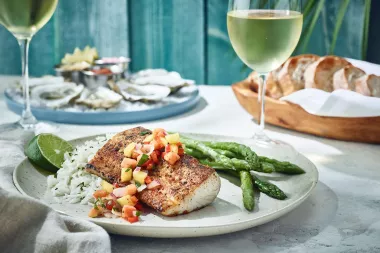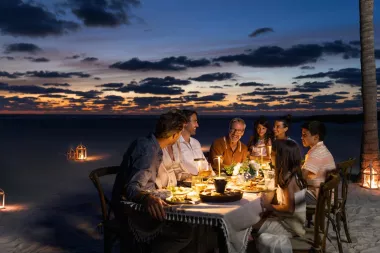Stone Crab 101: When, Where & How to Eat Naples Stone Crab Claws

Florida's Paradise Coast, encompassing Naples, Marco Island and the Everglades, is the birthplace of the stone crab industry and the nation's second-largest supplier of stone crab claws. From October to May, this area becomes the epicenter of stone crab activity. Here’s everything you need to know about Florida’s famed crustacean.
Everglades City: Stone Crab Capital of the World
Everglades City, with a population of around 500, is known as the Stone Crab Capital of the World. This area is one of the largest producers of stone crab claws – second only to the Florida Keys.
One of Everglades City's more colorful characters, Loren "Totch" Brown, claims to have "invented" the stone crab industry. Florida stone crabs used to be a nuisance to commercial fishermen who tried to catch pompano and mullet in their nets, but ended up with stone crabs instead. Brown saw a business opportunity.
"The thought came to my mind that they hadn't been commercialized any place in the United States, and that there ought to be some way to do it," Brown wrote in his book "Totch: A Life in the Everglades." Now deceased, Totch is credited by many with pioneering what is now a multimillion-dollar business and a lifeblood of the local economy.
Fun Facts About Stone Crabs
The stone crab's large claws can account for half its body weight.
Only the claws of stone crabs are harvested. The crab is put back in the Gulf of America alive, where it regenerates a new claw.
Stone crabs use shells as a tool to burrow into the sand. When you come across a stone crab home, it is often covered by shells.
Female stone crabs produce up to a million eggs at a time, and will produce from four to six egg sacs, called sponges, in a single spawning season.
The average life span of a stone crab is not known, but is estimated to be between seven and nine years in non-fished regions.
From Gulf to Restaurant: Stone Crab Harvesting
Florida’s Paradise Coast offers plentiful opportunities to savor the succulent flavors of stone crab. Adhering to regulations set by the Florida Fish and Wildlife Conservation Commission, crabbers follow harvest seasons and size limits to ensure industry sustainability. Once harvested, the claws are meticulously processed locally before reaching seafood markets and restaurants.
Each stone crab claw comes with a tale of hard work, dedication, and family ties. In the region, family-owned enterprises like Kirk Fish Co. and Grimm's Stone Crab are central to the stone crab industry. These fisheries, often passed down through generations, represent living legacies deeply embedded in the coastal communities they serve.
Southwest Florida crabbers work hard to harvest the delectable stone crab claws during the annual season. Harvested claws make their way to local restaurants, where they are incorporated into innovative dishes crafted by the Gulf’s top chefs.
How to Eat Stone Crabs
Stone crabs are considered a delicacy. Their price depends on the previous year’s harvest, amount purchased, and market prices. Claws are sold in fish markets based on size, and price per pound varies accordingly. The taste of stone crab is comparable to lobster. They are typically served chilled with a squeeze of fresh lime juice or accompanied by tangy mustard sauce.
Where to Eat Stone Crabs
City Seafood: Casual seafood joint with a covered outdoor patio with picnic tables overlooking the Barron River. Bring a cooler to stock up on fresh seafood at the market "to go." Have a cocktail, get their frozen key lime pie for dessert and buy a shirt to take home. Other best bets: whole smoked mullet, smoked fish dip, frog legs.
Grimm’s Stone Crab: Not a restaurant, but you can buy fresh stone crab claws here and they will crack them for you. Folks from Miami will actually drive over to Grimm’s for stone crab at better prices, and Grimm’s ships fresh overnight, nationwide. Don’t forget to buy mustard sauce!
Kirk Fish Co: A family-owned waterfront fish house in Goodland offering fresh stone crab claws. Nestled on Buzzard’s Bay, near Stan’s Idle Hour Bar and local restaurants, it’s a hub of activity. Visit by boat or car, and they'll pack your seafood with ice for the ride home.
Little Bar: Located in Goodland, Little Bar offers fresh stone crab during peak season, sourced locally from Kirk Fish. Owner Nikki Bauer emphasizes their commitment to quality, attracting patrons from near and far, including Europe and across the U.S., making it a must-visit for stone crab enthusiasts.
Triad Seafood Market and Café: Screened porch over the Barron River, fresh-fish market and all-you-can-eat stone crab specials (when available). Eat A LOT of stone crab claws and you can pin your photo to the Glutton Board alongside other crab connoisseurs. Other best bets: fried or grilled grouper, conch fritters, clam chowder, and fried gator tail.
Truluck’s: Located on 4th Avenue in Naples between Naples Bay and the Gulf, Truluck’s is a premier destination for those seeking culinary excellence. The elegant restaurant prides itself on its commitment to freshness, ensuring their stone crab claws go from traps to table within 24 hours and are never frozen during the season. Chef Estephan Fernandez attests to the unparalleled quality of their stone crab offerings.
Florida’s Paradise Coast is a true haven for seafood enthusiasts, especially those seeking the seasonal delicacy of stone crab. From fisheries in Everglades City to upscale restaurants in Naples, the journey of stone crab from ocean to plate highlights the area's strong sense of community, culture, and culinary excellence.
Explore More of Paradise Coast

Seafood Restaurants On Florida’s Paradise Coast That You Simply Have To Try

Waterfront Restaurants On Florida’s Paradise Coast

The Eclectic Dining Scene On Florida’s Paradise Coast

Your Guide To Must-Try Marco Island Restaurants And Bars

Sensational Naples Restaurants You Do Not Want To Miss
